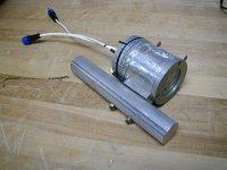
Sunphotometer
Aerosols, which are small liquid and solid particles suspended in the atmosphere, absorb and scatter incoming sunlight and thus possibly have an impact on atmospheric temperature. To study this effect the amount and size of the aerosols present in the atmosphere, are measured with a sun-photo-meter. In the broadest sense, a photometer is any instrument used to measure illuminance or irradiance. In photometry, illuminance is the total luminous flux incident on a surface, per unit area. It is a measure of the intensity of the incident light, wavelength-weighted by the luminosity function to correlate with human brightness perception. In photometry, illuminance is the total luminous flux incident on a surface, per unit area. It is a measure of the intensity of the incident light, wavelength-weighted by the luminosity function to correlate with human brightness perception.
The photometer is designed to observe certain narrow spectral bands of sunlight. A typical instrument will produce an output signal proportional to the solar irradiance within the intended spectral band. The instruments are used to deduce spectral atmospheric transmission, or optical depth, from which the contributions of various atmospheric constituents can be calculated; most commonly aerosol, but water vapour and ozone are also potentially derived. The spectral discrimination of the photometer is often accomplished with a narrowband interference glass filter which is the source of considerable uncertainty in the typical measurement. The filters used in some instruments have proven to be too unstable for long-term measurements at remote sites and are frequently calibrated.
